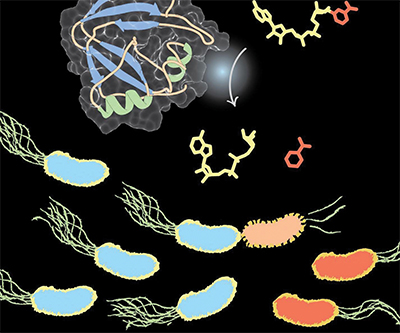JBC: New insights into the molecular weapons of the plant microbiome
Like all organisms, plants are associated with bacterial communities in which helpful and harmful bacteria compete for dominance. Among the weapons of these warring bacteria are molecular syringes that some bacteria can use to inject toxins into others. In published in the Journal of Biological Chemistry, researchers at in Canada pinpointed the identity of one such toxin used by a soil-dwelling bacterium that protects plants from disease.
 The NAD-degrading enzyme Tne2 is secreted through the type VI secretion system of the plant-protective bacterium Pseudomonas protegens.Courtesy of John Whitney/McMaster University
The NAD-degrading enzyme Tne2 is secreted through the type VI secretion system of the plant-protective bacterium Pseudomonas protegens.Courtesy of John Whitney/McMaster University
The bacterium Pseudomonas protegens can kill soil-dwelling plant pathogens, including fungi and bacteria, that attack the roots of important crops such as cotton. P. protegens releases diverse antimicrobial compounds into the soil, but was curious specifically about the compounds that it was injecting directly into other bacteria through the type VI secretion system, or T6SS.
The T6SS “is this molecular nanomachine that injects toxic protein into other species of bacteria and kills them,” Whitney said. “Plant protective bacteria that have (T6SS) can protect plants from pathogens better relative to (bacteria) that don’t have it.”
and , undergraduate students from the working with Whitney on a co-op work-study assignment, spearheaded the discovery that the toxic protein used by P. protegens against other bacteria acts on a molecule found in nearly all living cells: nicotinamide adenine dinucleotide, or NAD+.
NAD+ is a cofactor, or “helper” molecule, in many biochemical reactions. By injecting a protein that destroys NAD+, P. protegens is able to kill other bacteria.
The team then investigated the genome sequences of hundreds of other bacteria to see how widespread the strategy of targeting NAD+ is in microbial warfare. They found that many bacteria with secretion systems carry genes similar to the one encoding the NAD-targeting toxin.
“We started to see that this isn’t just a way of killing that is enacted by plant-protective bacteria,” Whitney said. “If you look at the distribution of this (protein) among all sequenced bacteria, it appears that many different bacteria in many different environmental niches use this mode of action to outcompete other bacteria.”
The abundance of these toxins in nature raises questions: How do different bacteria in different environments evolve to resist this toxin? Are NAD-targeting toxins more effective against some bacterial species than others? Understanding the diversity of bacterial weapons is an active area of study among agricultural researchers who would like to develop better ways to fight plant diseases.
“The identification and characterization of antibacterial toxins produced by plant-protective bacteria may one day allow us to engineer these bacteria to have enhanced ability to suppress pathogens,” Whitney said.
Enjoy reading 91��ɫ��ý Today?
Become a member to receive the print edition four times a year and the digital edition monthly.
Learn moreGet the latest from 91��ɫ��ý Today
Enter your email address, and we’ll send you a weekly email with recent articles, interviews and more.
Latest in Science
Science highlights or most popular articles

Exploring lipid metabolism: A journey through time and innovation
Recent lipid metabolism research has unveiled critical insights into lipid–protein interactions, offering potential therapeutic targets for metabolic and neurodegenerative diseases. Check out the latest in lipid science at the 91��ɫ��ý annual meeting.

Melissa Moore to speak at 91��ɫ��ý 2025
Richard Silverman and Melissa Moore are the featured speakers at the 91��ɫ��ý annual meeting to be held April 12-15 in Chicago.

A new kind of stem cell is revolutionizing regenerative medicine
Induced pluripotent stem cells are paving the way for personalized treatments to diabetes, vision loss and more. However, scientists still face hurdles such as strict regulations, scalability, cell longevity and immune rejection.

Engineering the future with synthetic biology
Learn about the 91��ɫ��ý 2025 symposium on synthetic biology, featuring applications to better human and environmental health.

Scientists find bacterial ‘Achilles’ heel’ to combat antibiotic resistance
Alejandro Vila, an 91��ɫ��ý Breakthroughs speaker, discussed his work on metallo-β-lactamase enzymes and their dependence on zinc.

Host vs. pathogen and the molecular arms race
Learn about the 91��ɫ��ý 2025 symposium on host–pathogen interactions, to be held Sunday, April 13 at 1:50 p.m.

.jpg?lang=en-US&width=300&height=300&ext=.jpg)